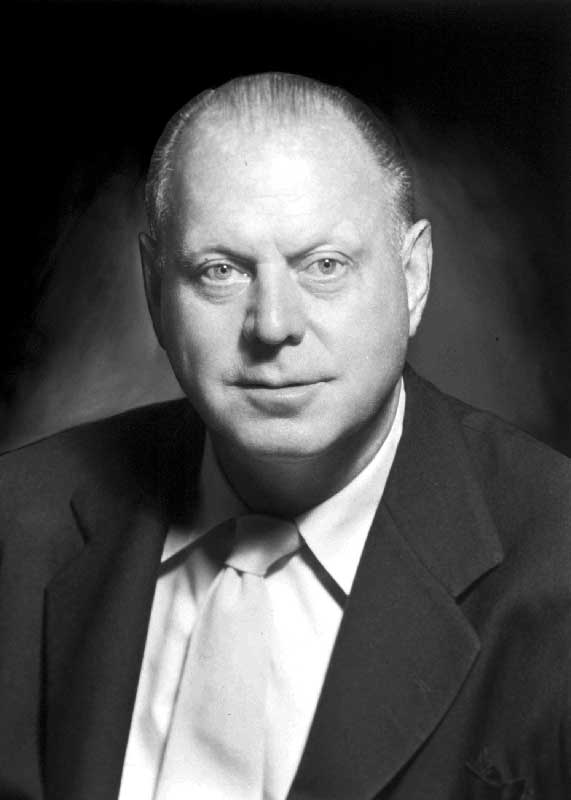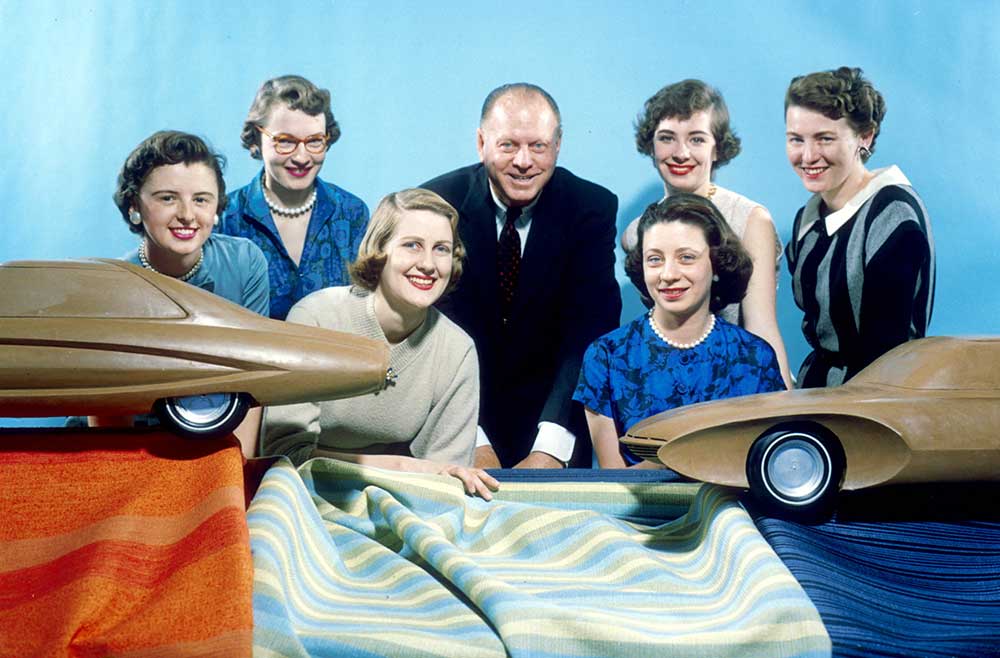I’m not sure of the source, the timeframe, or who is interviewing Harley Earl. But presented here is Harley’s recollection of his career at General Motors in his own voice. Patience: No audio for the first 10 seconds.
GM Damsels of Design Video
“The Museum of the City of New York, in conjunction with GM, hosted a tribute to the women of automotive design on Monday night. The event featured lots of documentary-style interview clips, politically incorrect GM promotional videos from the day and, the best part, live digital sketches done on the big screen by Cadillac’s Christine Park (see design progression after the jump). You might be familiar with Christine’s exploits on Cadillac XTS, the dashing concept that precedes the brand’s next generation flagship. Pictured here, GM’s famous “Damsels of Design” posed with none other than Harley Earl, GM’s first VP of Design. Earl created the need for an Art and Color Division at GM and brought us the industry’s first concept car, the Buick Y-Job. Wise beyond his years, Earl not only ushered in a sense of style and personalization to mass produced cars but hand picked a team of female designers to impress the papers and present a unique perspective to the design process.”



At about 28 minutes in, Harley mentions that, “Last year we started the Motorama as a new kind of auto marketing”. The first Autorama show was in 1949, but was not called the Motorama till 1953. This would indicate that the interview was probably conducted some time between 1950 and 1953.
Very interesting footage. But one should not view earlier events with 21st century eyes! After all look at the mess we are in now!
Seriously though I have always liked Earl’s work – he has quite a history – and it’s nice to hear the man speak.
Gary,
What a treasure this video is. Thank you for finding it and presenting it on the site. Amazing. And it ended on the Corvette.
When I started at Fisher Body in 1959 in Trim and Hardware Styling there were a lot of people that told me stories of what was done by Fisher and GM during the war. I also saw aircraft assembly drawings done during the war by Fisher Body.
By the way, Ken Pickering and Clare MacKichan both spent time their early in their careers.
Dick Ruzzin
I have had a copy of the Harley Earl audio for a few years and have played it at least 20 times. It really gives us an understanding of the world in which Mr Earl lived and the challenges he experienced in getting the design organization off the ground. I also found the war support coming from the Styling Section to be incredible. The best I can tell, the recording was probably done in 1952/53, judging by his reference to Watkins Gren and Corvette. It was a sudden, yet fitting end to the interview.
Hope all of you are doing well,
Ed Welburn
I believe Harley Earl’s interviewer for this tape was Stan Brams, and the interview took place in 1954. Stan died in 2000 at age 89. He was known as the dean of automotive journalists – highly respected – and wrote for a number of industry magazines and newspapers, including the Detroit Free Press, New York Times, Ward’s Auto World and Automotive News.
Fascinating hearing this recording of a man I only heard about, as a kid and later when trying to get into the field of automotive design. When I transferred to GM Styling from Fisher Body in 1969, the man who arranged everything, Ray Koenig, put me under the supervision of Masaji Sugano, sort of the senior tech stylist of Body Development Studio. Sugano, whom everyone called “Bud,” was a soft spoken Nisei who had started work after WWII as a board man, which I guess was what everyone called technical stylists. (I think that was a title created by the personnel department to make the job sound more professional. I was happy to be called either, because for me it was important just to be there.)
Bud patiently taught me how to do the work of the board man, along with John Kuhlman and John Hawkins, although he was willing to show me everything, whereas the Johns were somewhat guarded. In any case, what was interesting to me about Bud was a story I heard from someone in the studio, perhaps Ray Koenig, about his interaction with Harley Earl.
Reportedly, Bud was Mr Earl’s preferred board man and would visit him in the studio (not sure which) whenever he wanted to work up a design drawing of his own idea. As I recall the story, Mr Earl would take a chair in front of one of the 20 ft boards and actually tell Bud which sweep to use to create the line drawing, and in doing so, say something like this, “now ‘Jap,’ grab that P sweep and do…” this, that and the other thing with it in order to get the look that he wanted.
Ironically, Bud, an enlisted man during WWII, served as a translator for the army while his parents were interred in one of the camps in Montana (I think). After the war, he went to art school and then landed a job at GM.
Apparently, the relationship with Mr Earl went on for some time, when finally Chuck Jordan, as I recall the telling, screwed up enough courage to tell him that actually that term might very well be offensive to Bud. At that time, Bud was working for Jordan on the Aero Train, which is mentioned in the sound track. So as it turned out, from that day forward, Mr Earl switched to calling Bud “Chap,” without any indication that he’d ever said anything else, or of course any admission of offense.
Bud never told me anything about this situation as he had the utmost respect for Harley Earl, and I will always remember him fondly as the man who mentored me in my early days at what later became GM Design Staff. If anyone out there has better information about Bud and his relationship to Harley Earl, please feel free correct this anecdote, because while I in no way want to disparage Mr Earl, a larger than life creative powerhouse, I thought this an interesting story for the record.
Sheldon,
I think the term, and the profession, of Technical Stylist is a very important one. The studio engineers were the designer’s lawyers in the world of production engineering.
They understood where the designers were tying to go and were an enormous help in assisting them to push the boundaries. It is new technology that allows design to advance and the tech stylists were a big part in making that happen.
The other thing about the video was Harley Earls desire for concept cars that ran. Engineering Staff and Research labs must have had great fun in creating the Motorama show cars as they were not only design studies but also engineering dreams that ran
The less understood benefit to all of those cars was the advancement of the GM Styling design processes and the development of skills and experience that put them way ahead of the rest of the car design world. They also created a real draw for creative talent that lasted for a long time.
I was told by several Styling old timers that Harley Earl wanted to win in anything he participated in. That is why he hired semi-pro baseball players, championship bowlers and other professional athletes so that Styling would be the champions of all in house leagues at the GM Technical Center.
DICK RUZZIN
Yes Dick, I was proud to be a part of things as a Technical Stylist, because I was very much interested in vehicle architecture. Just recently I saw a posting on Facebook by John Manoogian publicizing a new book called “H Point” (I think) that explains the role of the technical stylist. And although I long ago left that role in my career, I intend to purchase a copy.
After reading about Harley Earl and his car designs for many years, it’s fascinating to actually hear his voice. Not what I expected–I thought he would sound “tougher”. Instead, he sounds vaguely like W.C. Fields. I think the American accent has changed (degraded?) over the past 60 years. I know of no modern adults who have the kind of inflections he has.
Automotive books often portray Earl as a brash, boorish showman of questionable taste who haphazardly stuck fins and chrome and bubble windshields on cars. What I’m hearing on this record is a man of measured stability, experience, and even a little humility (not wanting to take credit for the work of others). And Earl’s cars are generally the most admired, written about and collectable of all! So as Henry Ford said, “History [meaning the way it is popularly perceived] is bunk!”
Wonderful video, enigmatic interview – thanks for sharing these, Gary.
As someone just dipping a toe into the American car design waters, these really help set the scene. I echo the thoughts above mine that in the interview Earl comes across as quite humble and quite definitely proud of his and his team’s prodigious output. Designing thirty million and more cars in around twenty years staggers me. Throw trains and war work into the mix for added flavour! I had no idea GM ventured into these avenues.
Aside from the excellent interviewer, what helped make the setting even more real were the background noises; traffic and employees shaping materials, along with secretarial interruptions. A fabulous hour helping me understand how just one man set about designing design. Can you believe GM design is ninety four years old this year? The centenary needs to be as large as Earl’s legacy.
Some excellent anecdotes above, too. For someone who couldn’t draw, Mr Earl certainly had a knack of extracting the best out of his team, whatever the methods. A very different world. A very different man.